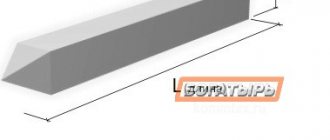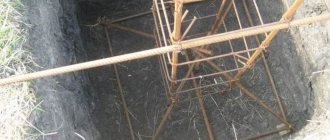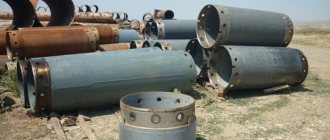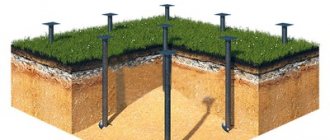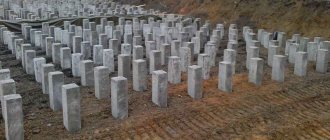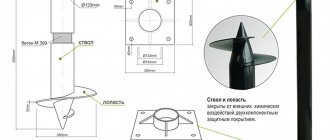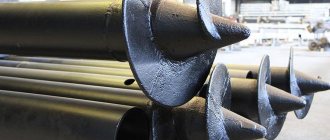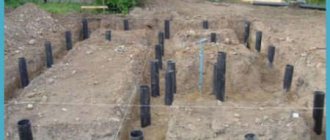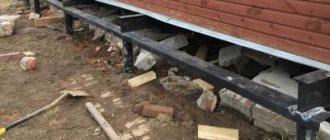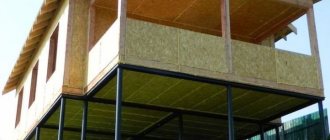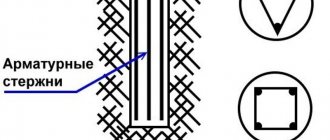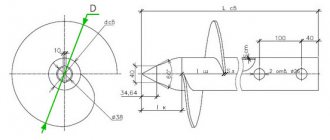Purpose
Reinforced concrete piles are used for foundations of industrial and residential buildings, warehouses, hangars, etc. On ordinary soils, multi-storey buildings are erected on such a foundation, creating high pressure on the surface. With the help of reinforced concrete piles for the foundation, it is possible to reduce the impact of the soil, ensure stability and avoid subsidence throughout the operation.
Pile foundations are suitable for unstable and wet soils, such as peat or marshy soils.
After geological exploration, the cross-section and length of the supports are selected and driven into stable ground. Next, a concrete grillage is poured, on which the walls of the building are erected. The purpose, number and type of piles used are determined by the designers.
Area of use of driven reinforced concrete piles
First of all, supports of this type are in demand for creating foundations on driven reinforced concrete piles during the construction of private and apartment buildings, buildings for various purposes.
In addition, driven reinforced concrete supports are used in the construction of structures:
- engineering and transport infrastructure (bridges, overpasses, etc.);
- hydraulic engineering purposes (piers, berths, water intakes, etc.);
- agricultural and industrial complex (hangars, workshops, warehouses, etc.).
Driven reinforced concrete piles of 300x300 mm and other sections can be used when reconstructing a finished pile field or strengthening it - their installation helps to more evenly distribute the load on the base. With the help of round piles, slopes and structures made of bulk materials are strengthened during road and railway construction.
Types and markings
Driven piles are classified according to the material from which they are made:
- Wooden, made from hard wood, oak or larch is often used. Their service life does not exceed 40 years; they are used in private construction for wooden or frame buildings that do not create high pressure on the ground.
- Steel, have a screw profile, and are made from rolled products with high strength. They are easy to install by hand, without heavy equipment. They are used for small structures in private construction. This type of support will last up to 60 years.
- Reinforced concrete is the most reliable foundation, designed for 150 years of service. Their popularity is due to the combination of affordable price and durability.
Separately, there are cast-in-place piles, which are hollow formwork or a hole in the ground, which are filled with reinforced concrete. They are more often used in private construction. Depending on the production methods, there are the following types of cast-in-place piles:
- Bored - a formwork is placed in the hole, into which reinforcement is placed, then filled with concrete. Pipes are used as formwork.
- Drilled injection - concrete is supplied to a drilled well under pressure to fill all the voids. Only after this the reinforcement is immersed in the concrete.
- Soil-cement - concrete solution mixed with soil is poured into the well. This is the cheapest option, but they have low strength and will last much less than a concrete base. Suitable for auxiliary structures.
The most common are driven and suspended reinforced concrete piles. They differ in the way they shrink. The driven supports rest against the hard rock with their tip. Friction piles are held in the ground due to a large contact area; they are used when it is impossible to reach a solid layer. According to the construction standards provided for by GOST 19804-2012, there are seven types of piles:
- with a square cross-section and transverse reinforcing mesh (C);
- round section made of reinforced concrete (SC);
- square with a circular cavity (SP);
- structures that are a durable shell for pouring concrete (CO);
- classic square section with longitudinal reinforcement (SC);
- square section with consoles for the extreme and middle axis of the base (1SD, 2SD).
Driven and pressed reinforced concrete piles have common technical characteristics:
- the minimum cross-section of a square is 30x30 cm, round and rectangular sections are allowed;
- the length can be from 2 to 16 m, in private construction 4-6 m are used, for greater depth, composite type structures are used;
- Concrete mixtures M200-M400 are used in production;
- high frost resistance corresponding to the F100-F500 markings;
- the lowest permissible moisture resistance rating is W2; for wet, swampy soils, the water resistance grade W8 is required.
Basic shapes and sizes:
1
2
3
Driven reinforced concrete piles
Driven reinforced concrete piles do not require site preparation for installation, as for bored supports. They are seated with a hydraulic or mechanical hammer.
Square piles
Square supports are designated by the letter “C”. There are no cavities in the body of the pile, so its length reaches 20 meters. This is required on sites with soft soils, where the hard layer is deep. The driven supports are made in sets, which allows the length to be increased to 28 meters. The side size of a square pile is from 20 to 40 cm. Concrete for the pile is poured onto a prestressed or conventional frame.
Square piles with a round cavity
The construction of square monolithic driven piles is facilitated by a cavity in the core. Such a support is marked with the combination “SP”. If a frame made of prestressing reinforcement is used in manufacturing, then “H” is added to the marking. The maximum length of one module is 12 meters. During installation, supports up to five meters are lifted with side grips, so they are produced without hinges. When making racks up to seven meters long, pins for slings are not installed. The latter are placed near the loops. The stability of the support is ensured by heavy concrete grade M300. The fraction for natural stone aggregate is no more than 2 cm.
The reinforcement diagram for hollow supports is shown in the illustration above. Transverse elements are wire with a cross-section of 5 mm. It is tied to vertical rods with knitting wire. Fixation is done at every fourth intersection to ensure uniformity of the spiral. The pitch of the turns on the first and last 40 cm is 5 cm. The middle part of the support has a larger distance between the turns: for supports up to 12 meters - 20 cm; for supports up to 6 meters – 30 cm.
The reinforcement is tensioned mechanically or electrothermally. In the first case, stretching devices without heating are used. Before electrothermal voltage, a voltage limit control test after heating is required. After pouring concrete into the stressed frame of the support, the reinforcement is cut flush. The transfer strength of concrete when cutting is not lower than 200 kgf/cm2.
After the concrete has gained strength, the support is checked for defects. To do this, the pile is laid on two pillars. After ten minutes, the top edge is inspected. The appearance of cracks on piles with unstressed reinforcement is allowed. The opening size is no more than 0.2 mm. There should be no damage to supports with a prestressing frame.
Round piles and shell piles
Round piles are produced with a cavity in the core. The supports are designated “SK”. Factories operating according to the state standard produce supports with a diameter of 40 to 80 cm. Round piles are independent supporting elements and are used in the same areas as square reinforced concrete supports. Shells are reinforced concrete products with a cross-section of up to 1.6 meters. There is also a cavity inside for filling with concrete. The purpose of shell piles is to hold the mass of concrete with a metal frame as formwork, designated “CO”. In reinforced supports, a “U” is added to the marking.
Like hollow piers, round and shell piles have an open or closed bottom end. For sectional modules, locking elements are installed at the ends. The fraction of crushed stone from natural stone used to fill concrete is 1-2 cm. The spatial frames of the supports are filled with a layer of concrete covering it on each side by 2 cm to prevent moisture from entering. For reinforcement, hot-rolled steel rods of class A3 or At3 are used. The spiral part is made of B1 or BP1 wire. The tips and locking modules of the support are assembled from sheet steel 1 mm thick.
When producing round supports and shells, it is allowed to weld the spiral with longitudinal rods. Winding is performed on machines. In the first 50 cm, the spiral is fixed at every third intersection. After 50 cm - at each intersection.
Piles-columns
The column pile is a monolithic support with a square section. It differs from ordinary square piles in its cantilevers. These are small projections on two or four sides of the element on which roof or foundation beams rest. The size of the support side is 20 or 30 cm. They are used for agricultural buildings with one floor.
Frame structures made of column piles can withstand seismic activity up to 7 points. The supports are immersed in the ground to a depth of 2 to 5 meters. Not used on heaving soils, embankments of sedimentary rocks and in areas with caster phenomena. In these cases, the pile will not provide the required load-bearing capacity in the soil.
On soft soils, the plinth beams rest on consoles. In this case, they are allowed to be immersed by 80 cm to distribute the load on the ground and supports. The console is placed under a plant or bulk layer to prevent the supports from moving. The production of reinforced concrete modules in a factory is shown below.
Advantages and disadvantages of pile foundations
Concrete piles are used to construct the foundations of private houses, outbuildings, multi-storey and industrial buildings. The popularity is due to the advantages of this type of foundation:
- installation on any type of soil, including unstable and swampy, the only limitation is rocky foundation;
- building a solid foundation in just one day; a classic strip foundation will take up to 7 days;
- the opportunity to save due to lower costs of materials - concrete by 30%, earthworks by 25%, without reducing strength characteristics;
- increased load-bearing capacity due to the strength of piles and other reinforced concrete products used for the foundation; one support can withstand a load of up to 50 tons;
- durability – up to 150 years.
The disadvantages of reinforced concrete foundation piles include:
- Limitation of the project due to the lack of a basement or ground floor;
- The requirements of SP 45.13330.2017 impose restrictions on the distances to the nearest buildings when working with hammers weighing more than 7 tons;
- Installation of the foundation requires special equipment;
- Careful geological exploration is required, which increases the cost of work. If they are not carried out professionally, the foundation may become deformed.
